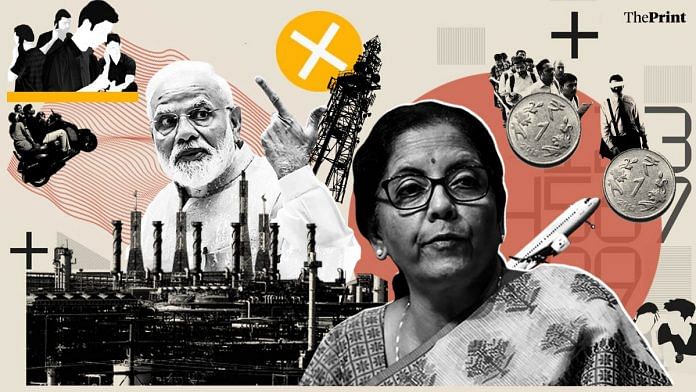Finance Minister Nirmala Sitharaman admitted in the Rajya Sabha Wednesday that the Indian economy had slowed down but clarified “it is not recession yet; it won’t be”. She said the slowdown didn’t unfold overnight and “there is a trail”. Sitharaman defended GST move but added that “it can do better” in terms of net collections.
ThePrint asks: Slowdown not recession says Nirmala Sitharaman: Is Modi govt still in denial on economy?
Five per cent growth isn’t recession, but slowdown of an economy reaching $3 trillion mark is worrying
 Ashutosh Sinha
Ashutosh Sinha
Business journalist
The Modi government is 100 per cent in denial of India’s economic slowdown. Capital investments are non-existent, companies are neither setting up factories nor investing in capacity. This is also corroborated by the fact that the capacity utilisation in the manufacturing sector is hovering around the 75 per cent mark.
There are two things at play here. First, companies are not setting up factories because investment is not being utilised. Second, the eight core sectors, which are 38 per cent of our economy, are also facing slowdowns. Further, electricity consumption is not looking good either.
When the market falls 20 per cent from the peak, stock markets declare it a bear market. In the face of overwhelming wholesale and retail data suggesting a downturn, I would say that the Modi government is in denial.
Growing at 5 per cent is technically not recession, but when an economy inching towards the $3 trillion mark slows down, one feels the pinch. There are three things that drive the market, first is sentiment, which is changing every minute. Second, markets tend to go up when capital is available, but fresh investments are not being made. Third, if 38 per cent of the economy (core sector) is not growing, how can the rest?
There is a need for big bang measures to drive the economy.
Spate of measures announced in last few months indicate Modi govt is not in denial about the economic slowdown
 Radhika Pandey
Radhika Pandey
Fellow, National Institute of Public Finance and Policy
The Modi government has over a couple of months announced measures to revive the economy out of a protracted slowdown. A cut in corporate tax rates, measures to boost bank lending, setting up a distressed asset fund to help give a kickstart to the real estate, sops for the auto sector and other such measures imply that the government has accepted the Indian economy is passing through a weak phase and requires policy intervention.
While the effectiveness and the timing of these policy measures are debatable, the spate of measures announced indicate the Modi government’s admission of the economic slowdown.
The typical definition of a recession is two quarters of negative growth. While we may not be in a recession yet and have not faced one in the post-liberalisation era, there is no denying the fact that our economy is in deep distress.
The last five quarters have seen a slowdown in GDP growth rate. There is a consensus that the GDP growth for the July-September quarter would have weakened further. Most of the high frequency indicators point to weak demand. The Modi government cannot afford to derive comfort from the policy measures it has announced so far. It needs to be recognised that economic recovery is going to be a slow process. Fundamental reforms rather than quick fixes are needed to arrest the slowdown and ensure long-term macroeconomic stability.
Views are personal.
If India’s GDP rate shows no signs of improvement, there will be political consequences

Narendar Pani
Professor, National Institute of Advanced Studies
The Narendra Modi government is denying the current economic slowdown. A developed economy’s growth rate is hurt deeply by a recession. But in the case of a developing economy where a substantial section of the population is still under pressure, a slowdown can, at times, have the same effect as a recession. Slowdown is the larger problem for India, we can’t wait for recession to hit the economy. India has never had a negative growth rate but that doesn’t mean that it is not facing a crisis now.
A slowdown can be attributed to two components: one, there has been a long-term failure of the economic liberalisation in the 1990s, particularly in terms of absorbing people left out of agriculture. Second, policies like demonetisation have made things worse.
Nirmala Sitharaman may have introduced sector-wise reforms, but it is imperative to understand what we mean by these reforms. Are they targeted at absorbing the labour force or are they simply targeted at a higher growth rate? We need to get rid of the knee-jerk statements about reforms.
If India’s GDP rate shows no signs of improvement, there will be political consequences, just like what happened in the West during the 2008 recession. Markers like stock markets doing well and foreign flows coming in are a sign of failure. If there is a collapse locally, then the stock market is completely dependent on foreign capital.
Unfair to term a 5 per cent growth rate as economic slowdown

Narendra Taneja
BJP National Spokesperson
I don’t think there is a question of the Modi government being in denial. There are economic challenges mainly because India is still an emerging economy. There have been challenges in the past, and there will be challenges in the future too. In fact, economies all over the world are facing such issues, it’s more so for emerging economies due to certain global factors.
If we look at the latest survey by the Economist magazine, it has listed India as one of the top ten fastest-growing economies in 2020. Further, it is not the first time that the growth rate has slowed down to 5 per cent. It has happened under former Prime Minister Manmohan Singh’s Congress government too, both in 2008 and 2013.
It is easy to draw political points out of this and condemn the Modi government. However, the fact is that India’s economy is fundamentally and structurally very sound.
We are facing technology and policy-led transitions in sectors such as automobile, telecom, energy, banking and finance and retail and trading. Facing economic challenges in times of such massive transitions are expected and inevitable. India is set to reach a 6.7 per cent growth rate again by the next financial year.
In the past, close to 50 per cent of our economy was black money economy, but after demonetisation, it is more formal than ever before. However, some problems will always arise because people resist such interventions. It would be unfair to term a 5 per cent growth rate as economic slowdown. India doesn’t claim to be a developed economy like Switzerland or Sweden yet, but its economy is stronger today with transparent and robust foundations.
Modi govt may not be in denial, but is far from taking responsibility for economic slowdown

Remya Nair
Senior associate editor, ThePrint
Nirmala Sitharaman, perhaps for the first time, admitted to India’s economic slowdown Wednesday since taking over as the Finance Minister in May despite being confronted with a slew of bleak macroeconomic data.
India’s economy has been sliding over the last one-and-a-half years led by a slowdown in investment and consumption. GDP data shows that the economy has been declining from the first quarter of FY 2018-19 and is expected to fall for the sixth consecutive quarter when the GDP numbers for the July-September quarter are released on 29 November. Economists expect the second-quarter GDP of FY20 to fall below 5 per cent.
The Modi government may no longer be in denial of the state of the economy, but is definitely far away from taking responsibility for the slowdown. It has preferred to blame the UPA government for its decisions taken years back.
The Modi government will have to acknowledge the fallout of some of its decisions like demonetisation and the hasty rollout of the GST on the economy and job market. It will have to announce steps to revive consumption and demand while assuaging fears expressed by businesses and investors over policy uncertainty and tax terrorism.
Also read: In just 4 months as finance minister, Nirmala Sitharaman has become face of India’s slowdown
By Kairvy Grewal, journalist at ThePrint




He is unable to understand why people pick on him. He gets up, does his Yoga, eats his super special breakfast, same everyday, and takes a shower, puts on a new dress for the day and then gets to work. At work he listens.I mean just listens ’cause folks need not know he follows the subject or not. The day ends with this and that but nothing significant. 24 hrs a day is hardly sufficient. Twitter reading and writing takes a lot of his time. What Economics???
Our Finance Minister why not accepting the reality of slowdown of economy. It’s the fact that is in foolsutopia . Unemployment, use of RBI’s Reserve funds, combination of banks, giving extra funds to National banks, closing co& factories, Small scale industrial markets are about to close . Today itself news has come GDP has touched to lowest up to 4.5 what more she needs.
India’s power consumption in October was 12% lower than a year earlier. For Maharashtra and Gujarat, down 22%. 20% in Karnataka. That is the severity of the challenge.
Power consumption is an unerring economic indicator, like bank credit and railway freight volume. What broke my heart is to read about how one litre of milk was split between 81 children in Yogiji’s Uttar Pradesh. This is the cost ordinary Indians are paying for ideology over the normal expectations from any government. This will more than “ dent “ Hindutva. It will damage and discredit it.
INDIA’S ECONOMIC OUTLOOK DISMAL – BEWARE THE COMING CATASTROPHE
In India a third of children have stunted growth and more 60% of its women are anaemic. That equates to hundreds of millions of our citizens.
Consider, Due to ill health and malnutrition before the age of four – the average IQ in India is less than 82.
In addition have very poorly educated young who are part of the demographic bulge, there will be no jobs for millions of youth.
With hundreds of millions unhealthy, uneducated and brains little better than morons, there seems to be no future for India, what in addition, to climate change and coming widespread water scarcity.
I immigrated to New Zealand after my son and daughter came back from a Delhi school constantly be harassed And bullied by the other children for being Muslim and told to go to Pakistan. My children will now will now grow up being hardworking loyal citizens here and contributing to secular high IQ New Zealand.
Meanwhile Indians look around you at the monuments that the Muslims left built, the great Muslim culture and language can be heard and seen all around you. During the time of the Mughals India contributed thirty percent of the world GDP.
It was a time when there was no communal feelings and no farmer suicide either. The Muslim rulers kept the exploitive Brahmins at bay, look what’s happened under Brahmin rule today.
As things get worse this abandonment of India will continue.
A small percentage of India’s rich And middle class will prosper while hundreds of millions will sink into the cess pit.
India’s Brahmins will rule the roost of a hungry population living in misery.
With average IQ of 82 the population will continues to manipulated by Political thugs.
Last night I was watching some clips of Singapore’s PM Lee’s recent speeches. The impact of the trade war on Singapore’s economy, growth prospects for ASEAN, the longer term geopolitical effects of worsening relations between America and China. Japan, South Korea, Australia and New Zealand merited a few mentions. Not one word about India. Either as a long term actor to balance China or a promising economy that the region wished to do more business with.
Recession in the West – where 2% growth is regarded as satisfactory – is defined as two successive quarters of contraction in economic activity. In the deepest winter of the Hindu rate of growth, India has never been there. So there are no gold medals for jumping over such a low bar. However, it is true that several industries are seeing negative growth. The revenue of the telecom sector – a sunrise industry – has declined from about 2.64 trillion a couple of years ago to about 2.25 trillion now. 2. In turn, government revenues are getting clobbered, whether it is GST or income tax. State finances / fiscal deficits are not better than the Centre’s. unclear which alignment of the planets we are waiting for to acknowledge the severity of the crisis and dealing effectively with.